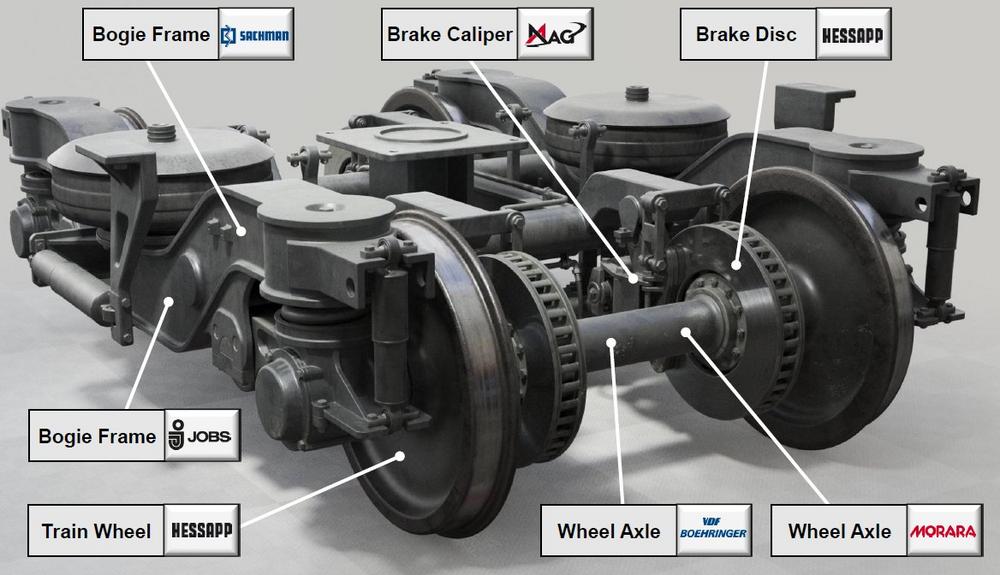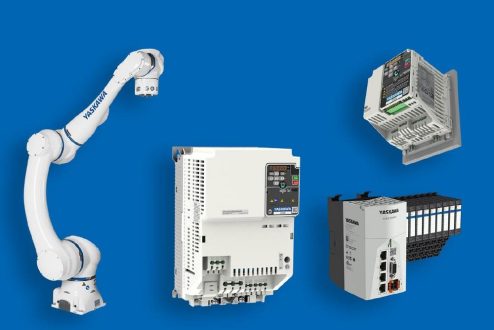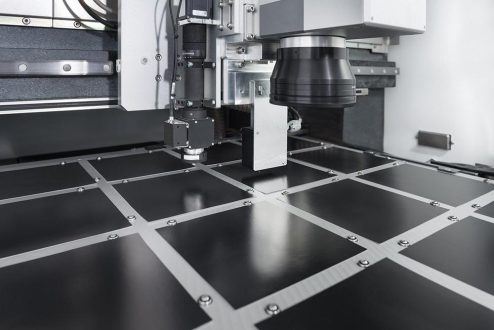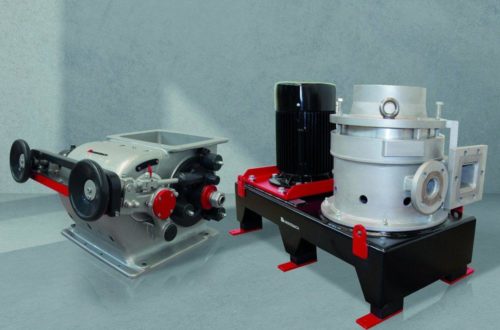
Production systems and manufacturing technologies for chassis and powertrain of rail vehicles
FFG Group has a complete product portfolio which covers all processes for the production of prismatic and rotary components such as: milling, drilling, turning, grinding and gear cutting for the respective manufacturing task for the chassis and drive of rail vehicles. The expertise and product portfolio are available in the individual companies and thus the customer can be promised an optimal solution for the specific component processing (Figures 1 to 3) within the group. The system supplier MAG (production locations: Germany, Hungary, USA, India and China) with professional project management is the coordinator with the competence for factory planning and supplying of turnkey systems.
Chassis frames and large structural components
There are two machine concepts available for the size of a chassis frame, both of which have a swivel spindle head. The swivel spindle offers an ideal solution for the structurally restricted access to the machining point. The gantry type milling center EVER5 (X / Y / Z: 9,500 / 4,000 / 1,250 mm) from JOBS (Fig. 4) with two work areas (fixture nests) on the table can be loaded and unloaded alternately, parallel to the main time, without interrupting processing. The traveling column machine THOR (X / Y / Z: 6,000 / 1,200 / 2,000 mm) from SACHMAN is equipped with a KOSMO milling head with a spindle speed of 4,000 rpm. With this solution, workpiece supply can also take place at the same time as the use of a second W-axis feed unit with an integrated B-axis rotary table in shuttle mode. The W-axis enables the workpiece to move towards the tool, particularly in the case of heavy and high-precision machining, and thus avoids a corresponding overhang on the tool side by moving out the Z-axis. Both machines can change the machining heads automatically and change tools via a sufficiently dimensioned tool magazine for complete machining of the bogies.
Machining of cubic housing components and turnkey production systems
The system competence for planning and execution of the FFG group is represented by the MAG brand. With its own product portfolio of special machines and CNC machines including process and equipment for machining, assembly and measuring stations, system automation (gantry loader or robot) and purchased systems, MAG supplies individual machines and production systems for the series production of housing components, e.g. cylinder blocks, cylinder heads, transmission cases, housings for e-drives, as well as complete turnkey systems for these components, according to the respective customer specification (Figures 5 and 6). An experienced team of project managers is available to coordinate the project and all co-suppliers. For project execution the latest software tools for the Digital Factory will be applied, e.g.: for the process design and optimization of the machining programs the virtual reality simulation is used. Simulation models are already created in the mechatronic design phase, with which virtual commissioning of the products and processes can be started even before the real system is built (Figure 7). In cooperation with the suppliers of special and peripheral machines as well as automation, the commissioning of the functions of a production system can be carried out on a virtual model without erection of the real units in one common location and in higher quality, lower costs and shorter delivery times compared to conventional project management. These models are also available to the customer as a demonstrator for training operators and maintenance personnel. In addition to the digital product twins, the digital process twin for processing sequence and digital system twin, which optimize the system for the desired availability and prove it on the simulation model, are created in the proposal phase.
Vertical machining of rotary components and housings
For the vertical machining of disc-shaped components such as railway wheels and brake discs, HESSAPP, with its many years of experience, offers a wide range of process knowledge for all core processes and optional technologies (ceramic components, lasers, hardening, grinding) for several complete series of turning machining centers (Table 1). The VDM series with sizes 550 to 1,600 mm is used for wheels and brake discs. With a maximum turning diameter of 1,600 mm (swinging diameter 1,800 mm), an output of 165 kW and a payload of 2.5 t, wheels with all material specifications (ER 6 to ER9) – regardless of the area of application of the wheels (freight, metro or high speed) – can be rough and finish machined with highest quality on the VDM 1600 machine with a capacity of 48 tool positions (Figure 8). The VDM 1000 machine is an economical counterpart for smaller wheels with a turning diameter of up to 1,150 mm.
The DVH 750 turning machining center and the DVT 750 transfer machining center are ideal for self-loading and pick-up machines of brake discs up to workpiece diameter of 750 mm. With the integrated workpiece change from the infeed conveyor through the movable work spindle and delivery of the machined workpiece to the outfeed conveyor, both machines are more comparable to a production cell without additional investment in automation. The transfer machine HESSAPP DVT 750 is a compact vertical turning cell for two-sided complete machining. With the two turning spindles, extensive and qualitatively demanding features can be machined on the workpiece. The technological capabilities of the HESSAPP DVT 750 thus make it possible to dispense a subsequent station to complete the processing. A standing, stationary and a movable, hanging spindle machine both sides on two workpieces in the machine in parallel operation and transfer the workpieces without additional equipment (Fig. 9).
Horizontal machining of shafts and axes
The powerful horizontal CNC lathes of the VDF series from BOEHRINGER are designed for hard machining and highest component quality. With frame sizes VDF 450 and 650, all requirements for the wheelset axles and drive shafts can be covered and the required processes (rough turning, fine turning, milling, gear cutting and other machining with driven tools (drilling, threading, milling)) can be covered (Fig. 10). The machines are built on hydropol beds for maximum mechanical and thermal stability. This achieves maximum vibration damping as the basis for the finest surface quality, extended tool life and thus reduced tool costs. With the process know-how of the BOEHRINGER turning specialists, these robust, durable and high-precision machines produce grinding qualities when required.
The horizontal and vertical CNC lathes of the brands HESSAPP and BOEHRINGER are intended for integration in complete production systems (Figures 8 and 11) and can be ideally integrated into an automation concept with the interfaces provided and can be loaded and unloaded fully automatically from above and from the front . The supply and disposal of the machines (swarf and suction) can be configured either centrally or decentralized. For maximum indispensable availability within an automated manufacturing system, the accessibility is designed for the shortest service interventions. The parts and components used meet the high production demands of a three-shift operation of up to 18/19 shifts per week with a service life of >15 years and the permanent machining accuracy.
The product MORARA MT 2500 HD (Figure 12) for shaft components with a length of 2,600 (3,000; optional) mm and a weight of up to 2 t is available from FFG’s Grinding Solutions division for the finest machining of axes and shafts. The machine is particularly characterized by its productivity and process flexibility, as well as its high energy efficiency and compact footprint. Like all FFG machines for integration in production lines, loading from the front and top can be carried out fully automatically or manually (stand-alone). With a maximum grinding diameter of 350 mm and two grinding units (optional) on high-precision slide and feed units, driven by linear motors, the axles and drive shafts for rail vehicles can be finished in one clamping.
The thermal control of all machine assemblies including the linear drives through their integrated cooling circuits, ensures the high-precision machining level of the machine and is supported by the hydrodynamic bearings of the self-balancing grinding spindles with a 46 kW drive power (up to 50 m/s circumferential speed of the wheels) and the resulting long service life. With a B axis for the right grinding unit, conical areas on the workpiece can also be machined in the range +/- 5 ° with a resolution of 0.0001 °.
Turning and gear hobbing wheels and pinions
Vertical lathes of the brands HESSAPP and SMS are suitable for machining the gearwheels in the powertrain of the driven vehicles. The gear cutting machines from MODUL H 600 to H 2300 are designed for the series production of large gears up to m <28 and workpiece diameters up to 2,400 mm. The machines can be used for all hobbing and form milling processes for soft machining as well as for the finished machining of hardened gears. In addition to spur gears, helical gears, spherical or conical gears can be manufactured using hardware and software options as well as shafts with multiple gears, worm gears and other special profiles. The MODUL H 600 to H 800 series is loaded with the integrated ring loader. The larger machines are linked with classic automation systems (e.g. portal loaders, robots, etc.). In accordance with the high machining forces and stresses involved in the manufacture of gears, the large MODULE H 900 to H 2300 series features box ways with coating.
Wheelset machining for maintenance
The machining of vehicle wheelsets for the service is becoming increasingly important. Recent studies [1,3,4] do recommend the machining of the wheels at each service stop (approx. 70,000 km) with a material removal of 1 mm compared to the previous condition-based reworking of the profiles with a material removal of 4 – 5 mm. The elimination of surface defects in the rolling contact area that begin with fatigue crack formation are the new approaches to significantly reduce maintenance costs in connection with a possible doubling of the service life to up to 1.6 million km mileage [2]. In addition to special machines for turning wheelsets in an installed (underfloor lathes) or removed (above-floor gantry machines) condition, CNC lathes such as the BOEHRINGER VDF DUS 800/1000/1110 (turning length 820 to 1,110 mm above bed, Figure 14) up to size VDF 1300/1500/1600 DUS (1,300 to 1,600 mm above bed) are also available for the repair shop for smaller series. A highlight of the series are the hardened double prism guides with scraped guide surfaces on the slide, which are the basis for the high and durable machining accuracy and highly economical production.
FFG Group offers itself as an ideal partner with the wide range of manufacturing machines for different technologies in the area of drives and running gear for rail vehicles. Due to the turnkey system competence, peripheral systems up to complete production plants can be planned and handled. In close cooperation with the plant operator, the appropriate technologies from the partly overlapping product portfolio are selected in the planning phase, taking customer preference into account, and the most cost-effective solution for high productivity is worked out with regard to the required flexibility of the technologies, component bandwidth and production volume. With globally available efficient service and a special memorable training program for operators and maintenance personnel, the robust and durable products unfold their full efficiency using the latest technologies.
References
[1] Boudnitski, G., Edel, K.-O.: Oberflächendefekte im Scheibenbereich, Abschlussbericht zum DFG-Projekt, Brandenburg an der Havel, April 1998
[2] Müller, R. et al.: Definition on wheel mainenance measures for reducing ground ibration, EU FP7 Project RIVAS, SCPO-GA-2010-265754, Nov. 2013
[3] Alstom: Technical specification wheel wear analysis, CCN-WR-Analysis, 22.12.2003
[4] Muhamedsalih, Y., Stow, J., Bevan, A.: Use of railway wheel and damage predicitions tools to improve maintenance efficiency through the use of economic tyre turning (ETT), Institute of Railway Research, University of Huddersfield, UK; in: Journal of Rail and Rapid Transit, July 2010
FFG Europe & Americas MAG IAS GmbH
Salacher Straße 93
73054 Eislingen
Telefon: +49 (7472) 168-0
Telefax: +49 (7472) 168-334
https://ffg-ea.com/de
Telefon: +49 (7161) 805-4900
Fax: +49 (7161) 805-2630
E-Mail: manfred.berger@mag-ias.com
PRX Agentur für Public Relations GmbH
Telefon: +49 (711) 7189903-04
Fax: +49 (711) 71899-05
E-Mail: ralf.haassengier@pr-x.de
![]()



